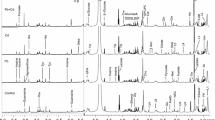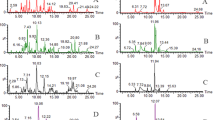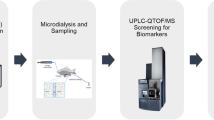Abstract
Bioindicators can reflect the effects of pollutants on their metabolism, being widely used to assess environmental stress. In this sense, the crab Procambarus clarkii has been previously proposed to monitor the contamination in Doñana National Park (southwest Spain) using conventional biomarkers. In this work, a metabolomic approach based on direct infusion mass spectrometry, which allows an easy and quick study of a large number of metabolites in a single run, was used for pollution assessment of this area, considering the biological response of this organism to contamination. In addition, metal accumulation in crab tissues was determined. Thus, the integrated analysis of metabolomic and metallomic data enabled the study of metabolic response of the organism against pollution. Several metabolites were discovered as potential biomarkers of pollution, such as decreased levels of carnosine, alanine, niacinamide, acetoacetate, pantothenic acid, ascorbate, glucose-6-phosphate, arginine, glucose, lactate, phospholipids, and tryglicerides, as well as elevated levels of acetyl carnitine, phosphocholine, choline, and uric acid. In this way, metal-induced toxicity could be related to metabolic impairments, principally oxidative stress, metabolic dysfunction, and dyslipidemia.




Similar content being viewed by others
References
Alcorlo P, Otero M, Crehuet M, Baltanas A, Montes C (2006) The use of the red swamp crayfish (Procambarus clarkii, Girard) as indicator of the bioavailability of heavy metals in environmental monitoring in the River Guadiamar (SW, Spain). Sci Total Environ 366:380–390
Arnal N, de Alaniz MJT, Marra CA (2011) Carnosine and neocuproine as neutralizing agents for copper overload-induced damages in cultured human cells. Chem-Biol Interact 192(3):257–263. doi:10.1016/j.cbi.2011.03.017
Beeby A (2001) What do sentinels stand for? Environ Poll 112:285–298
Blasco J, Puppo J (1999) Effect of heavy metals (Cu, Cd and Pb) on aspartate and alanine aminotransferase in Ruditapes philippinarum (Mollusca: Bivalvia). Comp Biochem Physiol C-Toxicol Pharmacol 122(2):253–263
Bonvillain CP, Rutherford CA, Kelso WE, Green CC (2012) Physiological biomarkers of hypoxic stress in red swamp crayfish Procambarus clarkii from field and laboratory experiments. Comp Biochem Physiol A-Mol Integr Physiol 163:15–21
Bundy JG, Davey ÆMP, Viant MR (2009) Environmental metabolomics: a critical review and future perspectives. PubliCat 5(1):3–21. doi:10.1007/s11306-008-0152-0
Chinni S, Yallapragada PR (2002) Energy levels of Penaeus indicus postlarvae on exposure to lead. Ecotox Environ Safe 52:173–179
Cruz MJ, Rebelo R (2006) Colonization of freshwater habitats by an introduced crayfish, Procambarus clarkii, in Southwest Iberian Peninsula. Hydrobiologia 575(1):191–201. doi:10.1007/s10750-006-0376-9
Depeint F, Bruce WR, Shangari N, Mehta R, O’Brien PJ (2006) Mitochondrial function and toxicity: role of the B vitamin family on mitochondrial energy metabolism. Chem-Biol Interact 163:94–112
González-Domínguez R, García-Barrera T, Gómez-Ariza JL (2012) Metabolomic approach to Alzheimer’s disease diagnosis based on mass spectrometry. Chem Pap 66(9):829–835
Grimalt JO, Ferrer M, Macpherson E (1999) The mine tailing accident in Aznalcollar. Sci Total Environ 242(1–3):3–11
Halliwell B, Gutteridge JMC (1999) Free radicals in biology and medicine. Oxford University Press, Oxford
Hodkinson ID, Jackson JK (2005) Terrestrial and aquatic invertebrates as bioindicators for environmental monitoring, with particular reference to mountain ecosystems. Environ Manage 35(5):649–666
Kohen R, Yamamoto Y, Cundy KC, Ames BN (1988) Antioxidant activity of carnosine, homocarnosine, and anserine present in muscle and brain. Proc Natl Acad Sci U S A 85:3175–3179
Limón-Pacheco J, Gonsebatt ME (2009) The role of antioxidants and antioxidant-related enzymes in protective responses to environmentally induced oxidative stress. Mutation Res 674:137–147
Liu X, Zhang L, You L, Cong M, Zhao J, Wu H, Li C, Liu D, Yu J (2011a) Toxicological responses to acute mercury exposure for three species of Manila clam Ruditapes philippinarum by NMR-based metabolomics. Environ Toxicol Phar 31:323–332
Liu X, Zhang L, You L, Yu J, Cong M, Wang Q, Li F, Li L, Zhao J, Li C, Wu H (2011b) Assessment of clam Ruditapes philippinarum as heavy metal bioindicators using NMR-based metabolomics. Clean Soil Air Water 39:759–766
Livingstone DR (2001) Contaminant-stimulated reactive oxygen species production and oxidative damage in aquatic organisms. Mar Pollut Bull 42:656–666
Lobinski R, Moulin C, Ortega R (2006) Imaging and speciation of trace elements in biological environment. Biochimie 88:1591–1604
Martín-Díaz ML, Blasco J, Sales D, Delvalls T (2008) Field validation of a battery of biomarkers to assess sediment quality in Spanish ports. Environ Poll (Barking Essex 1987) 151(3):631–640. doi:10.1016/j.envpol.2007.03.019
Morris S, van Aardt WJ, Ahern MD (2005) The effect of lead on the metabolic and energetic status of the Yabby, Cherax destructor, during environmental hypoxia. Aquat Toxicol 75:16–31
Oñate JJ, Pereira D, Suarez F (2003) Strategic environmental assessment of the effects of European Union’s regional development plans in Doñana National Park (Spain). Environ Manage 31:642–655
Phillips DJH, Rainbow PS (1993) Biomonitoring of trace aquatic contaminants. Elsevier, London
Reddy PS, Bhagyalakshmi A (1994) Changes in oxidative metabolism in selected tissues of the crab (Scylla serrata) in response to cadmium toxicity. Ecotox Environ Safe 29:255–264
Rosenberg DM, Resh VH (1993) Freshwater biomonitoring and benthic macroinvertebrates. Chapman and Hall, London
Sánchez-López FJ, Gil-García MD, Sanchez-Morito NP, Martínez-Vidal JL (2003) Determination of heavy metals in crayfish by ICP-MS with a microwave-assisted digestion treatment. Ecotox Environ Safe 54:223–228
Sánchez-López FJ, Gil-García MD, Martínez-Vidal JL, Aguilera PA, Garrido-Frenich A (2004) Assessment of metal contamination in Doñana National Park (Spain) using crayfish (Procamburus clarkii). Environ Monit Assess 93(1–3):17–29
Schilderman PA, Moonen EJ, Maas LM, Welle I, Kleinjans JC (1999) Use of crayfish in biomonitoring studies of environmental pollution of the river Meuse. Ecotoxicol Environ Saf 44:241–252
Sevillano M, González-Fernández M, Jara-Biedma R, García-Barrera T, López-Barea J, Pueyo C, Gómez-Ariza JL (2012) Biological response of free-living mouse Mus spretus from Doñana National Park under environmental stress based on assessment of metal-binding biomolecules by SEC-ICP-MS. Anal Bioanal Chem 404(6–7):1967–1981. doi:10.1007/s00216-012-6274-2
Torreblanca A, Del Ramo J, Diaz-Mayans J (1991) Effects of cadmium on the biochemical composition of the freshwater crayfish Procambarus clarkii (Girard, 1852). Bull Environ Cont Toxicol 47:933–938
Vioque-Fernández A, Alves de Almeida E, Ballesteros J, Garcia-Barrera T, Gomez-Ariza JL, Lopez-Barea J (2007) Doñana National Park survey using crayfish (Procambarus clarkii) as bioindicator: esterase inhibition and pollutant levels. Toxicol Let 168:260–268
Vioque-Fernández A, Alves de Almeida E, López-Barea J (2009) Assessment of Doñana National Park contamination in Procambarus clarkii: integration of conventional biomarkers and proteomic approaches. Sci Total Environ 407(5):1784–1797
Wang SY, Stickle WB (1988) Biochemical composition of the blue crab Callinectes sapidus exposed to the water-soluble fraction of crude oil. Mar Biol 98:23–30
Wang J, Pan Y, Hong Y, Zhang QY, Wang XN, Kong LD (2012) Quercetin protects against cadmium-induced renal uric acid transport system alteration and lipid metabolism disorder in rats. Evid Based Complement Alternat Med 2012:548430. doi:10.1155/2012/548430
Winston GW, Di Giulio RT (1991) Prooxidant and antioxidant mechanisms in aquatic organisms. Aquat Toxicol 19:137–161
Zhang L, Liu X, You L, Zhou D, Yu J, Zhao J, Feng J, Wu H (2011a) Toxicological effects induced by cadmium in gills of Manila clam Ruditapes philippinarum using NMR-based metabolomics. Clean Soil Air Water 39:989–995
Zhang L, Liu X, You L, Zhou D, Wu H, Li L, Zhao J, Feng J, Yu J (2011b) Metabolic responses in gills of Manila clam Ruditapes philippinarum exposed to copper using NMR-based metabolomics. Mar Environ Res 72:33–39
Acknowledgments
This work was supported by the projects CTM2012-38720-C03-01 from the Ministerio de Economia y Competitividad and P008-FQM-3554 and P009-FQM-4659 from the Consejería de Innovación, Ciencia y Empresa (Junta de Andalucía). Raúl González Domínguez thanks the Ministerio de Educación for a predoctoral scholarship.
Author information
Authors and Affiliations
Corresponding authors
Additional information
Responsible editor: Markus Hecker
Rights and permissions
About this article
Cite this article
Gago-Tinoco, A., González-Domínguez, R., García-Barrera, T. et al. Metabolic signatures associated with environmental pollution by metals in Doñana National Park using P. clarkii as bioindicator. Environ Sci Pollut Res 21, 13315–13323 (2014). https://doi.org/10.1007/s11356-014-2741-y
Received:
Accepted:
Published:
Issue Date:
DOI: https://doi.org/10.1007/s11356-014-2741-y




